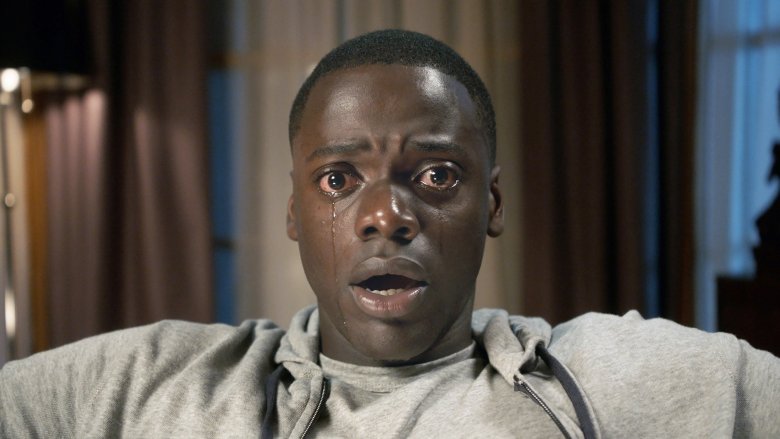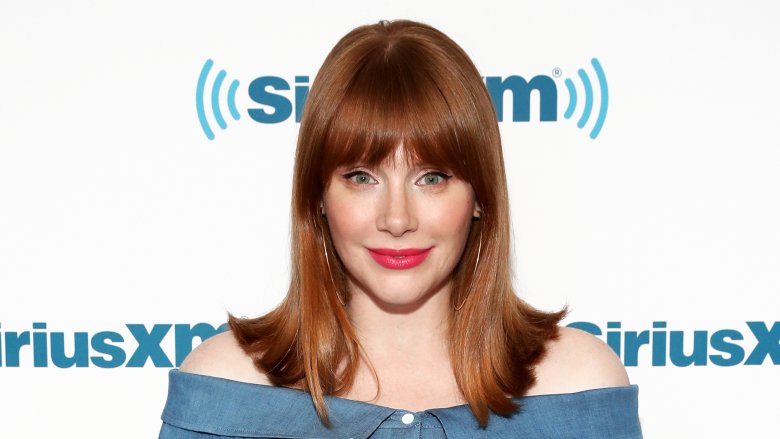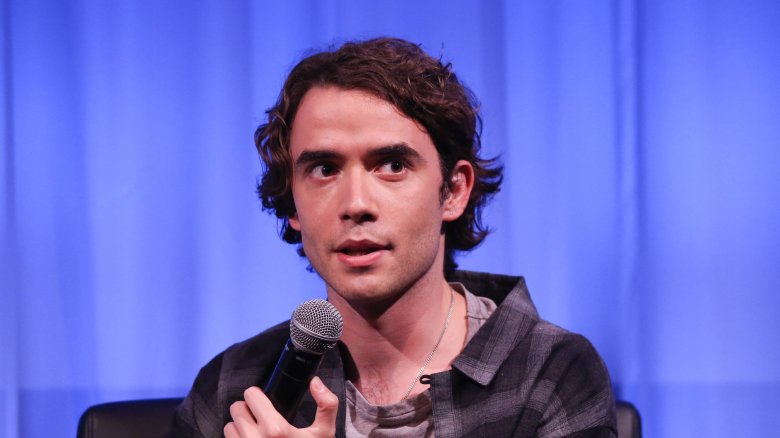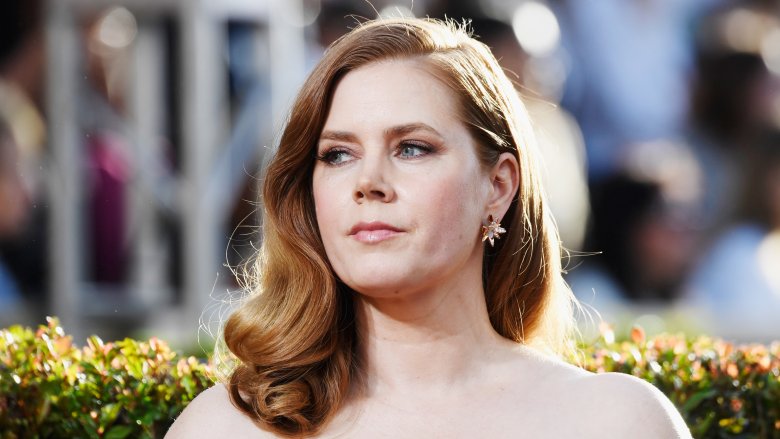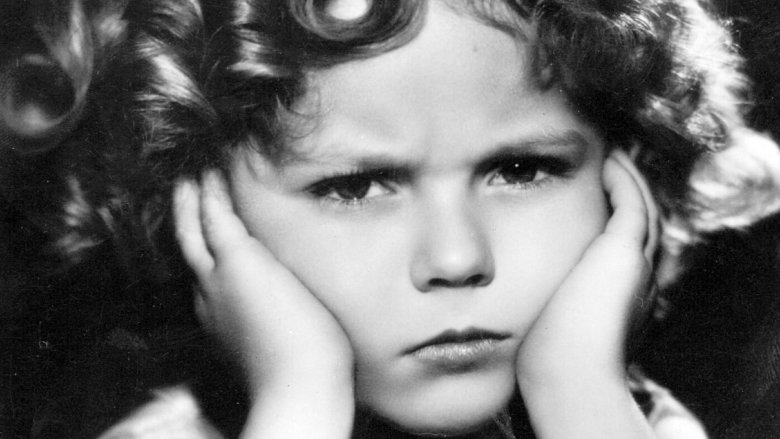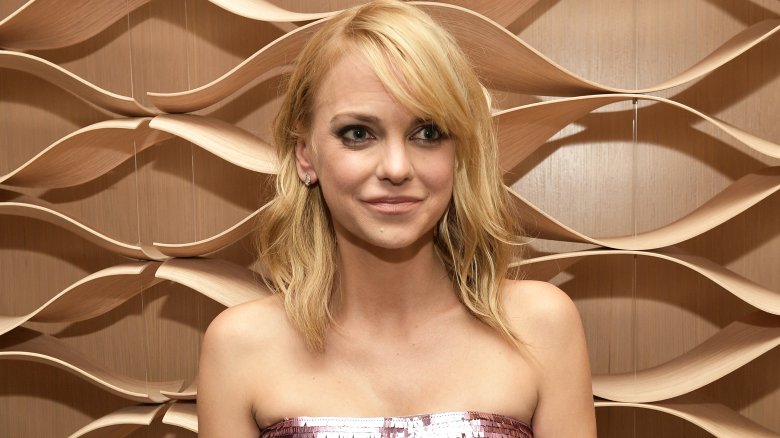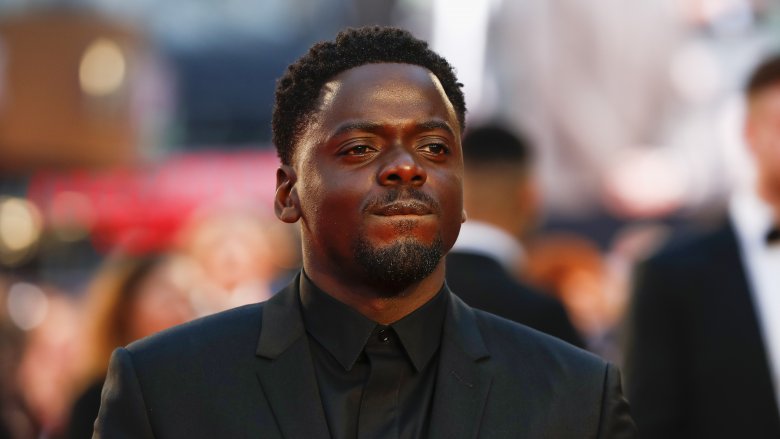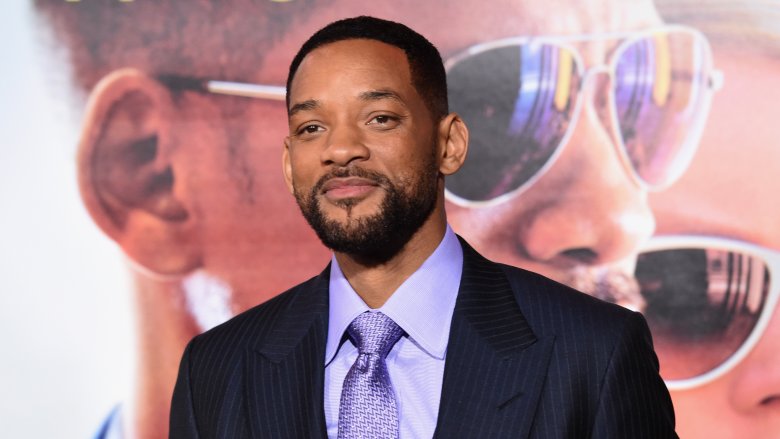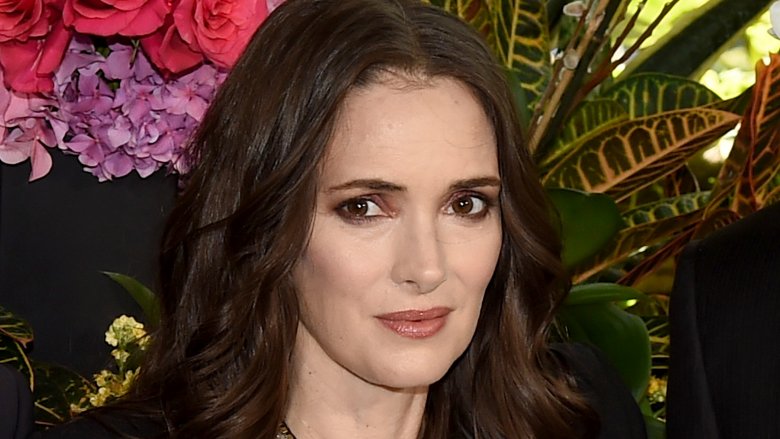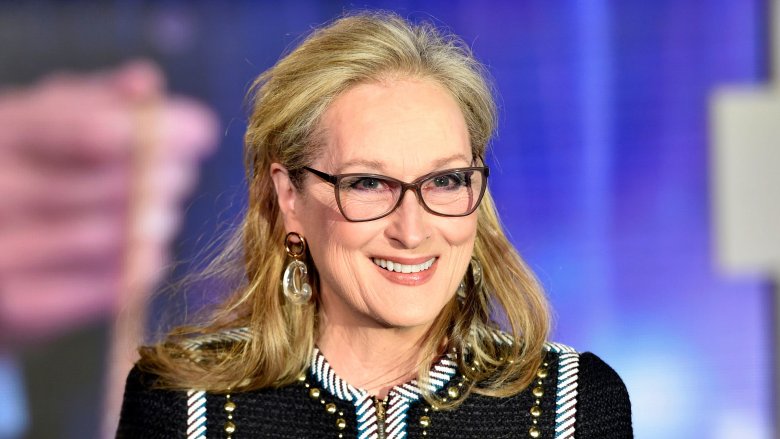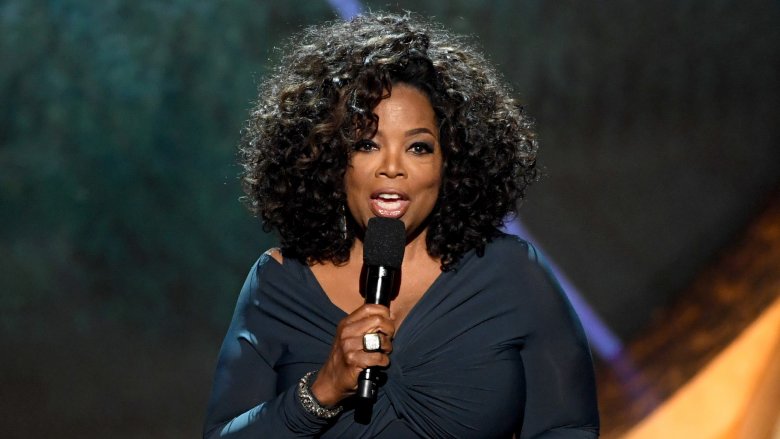This Is How These Actors Fake Cry In Movies
There are a few staples of the craft that any actor worth their salt should have a solid command of. They ought to be able to keep a straight face even when their screen partner is doing something hilarious, for one thing. And pulling off a key love scene is often a make-or-break matter for a movie — even if it's completely awkward for everyone involved, those on-screen lovebirds need to look like they're enjoying it.
Perhaps the most helpful, albeit difficult talent for any film actor to have is the ability to cry on command. Whether it's to portray a moment of pain, grief, anger, desperation, or even glee, there are a lot of pivotal movie scenes that really require thespians to crank up the waterworks and send home the emotion of the moment. So, how do these stars manage to trickle out those tears again and again with each take? Let's take a look at how some of Hollywood's finest make it happen.
Some can trick their eyes into producing tears
It may not be common, but there are some actors who have the ability to summon up authentic sobs by sheer force of will (and lots of practice). Bryce Dallas Howard famously demonstrated her natural gift for crying on command during an interview with Conan O'Brien. First, she told him that she'd just need him to start talking about something, anything to allow her to work. Lo, as the show host started going on and on about some made-up trip to his local Home Depot, she managed to squeeze out a few very real tears in the span of two minutes.
The actress later returned to the same show and explained that it's not her genetics that give her the ability to cry on cue. "It's technical. It's something that can be learned and taught," she said before sharing some of the details of her method. As it turns out, for Howard, inducing the soft palate lift that comes with yawning again and again will help her produce those crocodile tears. "You do it enough time and when you're talking you can continue to lift it," she explained. "It triggers it, just talking about it for me, it's like a physiological thing." The biggest key, she added, was to stay hydrated all the while so that there's plenty of H2O to spare in her system.
Sometimes, it sounds a little dangerous, too
Like Bryce Dallas Howard, If I Stay star Jamie Blackley said that he too relies on an unseen bodily cue to bring about his fake tears for those sadder scenes. Only instead of focusing on flexing his soft palate to get the water flowing, he goes an entirely different route that doesn't exactly sound healthy. The actor explained in a 2014 promotional interview, "You can make all the blood rush to your head... if you squeeze."
Chances are, there are all manner of complications that could emerge from forcing a blood rush to the brain again and again as such scenes are shot and re-shot, so this is definitely an instance of an actor suffering for his art. However, his back-up approach does sound a little bit safer: Blackley also mentioned thinking of "a poor puppy on the street who's crying" to drum up the requisite sensation and shed a few. Considering how much emotion he had to show for his teen romantic drama, let's hope he stuck to the latter option more often than the former.
Others go back to a story or memory for inspiration
Amy Adams can also turn on the sprinklers at a moment's notice, but instead of relying on a physical trick, she uses a strange bit of memory recall to make it happen. The acclaimed actress has repeatedly demonstrated her own trick on several late night talk shows, including The Tonight Show Starring Jimmy Fallon and The Graham Norton Show, and of all the things that could get her worked up, her go-to is a bit about hot sauce.
That's right, the actress revealed that her daughter helped coax her into crying on cue by telling her about a 2013 news story about a Sriracha plant in California being shuttered after complaints by neighbors about the unpleasant fumes issuing from the production facility. Evidently, Adams is a big enthusiast of the spicy sauce, so that little tidbit did the trick to get her weeping, and it's what she turns to anytime she needs something to bawl about. Hollyweird.
Some just need to think of nothing at all
The late, great Shirley Temple might have been just a tiny tyke when she became a legend of the early screen scene, but even then she was a consummate professional. In a 1999 interview (via the Associated Press), the former child superstar revealed her method for breaking out with a wail on camera, saying, "I guess I was an early method actress. I would go to a quiet part of the soundstage with my mother. I wouldn't think of anything sad, I would just make my mind a blank. In a minute I could cry." That talent would come in handy later in life when she used it to get out of a speeding ticket. Stars... they're just like us!
Temple did have one caveat to mustering up the mopes, though. Like most little ones, mealtimes mattered a lot in her life, so once her belly was full (of animal crackers in her soup, no doubt), she couldn't do it anymore. "I didn't like to cry after lunch," she said, "because I was too content."
There are also things they can buy to help
Hollywood is all just a game of smoke and mirrors... and apparently, tear sticks. At least one actress has copped to faking her crying scenes with the help of some artificial tears. Mom star Anna Faris told James Corden that she isn't the type of person who can easily sob in real life, and it's not any easier for her to do so for the cameras, either. "It's actually, it's a little bit weird. Because my mom always taught me — if I ever cried in my personal life, she would sort of come down on me, like 'What do you have to feel sorry for?'" she explained.
So, instead of trying to power through with real tears, she relies on a device called a tear stick, which she brought along for demonstration. Faris, Corden, and fellow guest Josh Jackson each agreed to have the menthol crystal vapors blown into their eyes to demonstrate for the crowd, and within seconds, they were each dripping with tears. That's when Jackson revealed the secondary trick to selling these fake tears on-screen by advising Corden: "Now look three-quarters away and slightly up." Nailed it.
Thinking of others is also effective
Some actors don't have to stretch their minds too far to get worked up enough to produce the requisite tears for a tough scene. Daniel Kaluuya, for example, revealed that while filming the stand-out "Sunken Place" scene for Jordan Peele's Get Out — during which he was physically frozen and gutted audiences with those thick teardrops — he just thought about what it would be like to be in a similar situation in real life.
In an Actors on Actors chat for Variety, he explained that while part of tapping into that headspace to cry involved ditching out on his usual routine of talking to and joking around with the cast and crew on set, it was also about recognizing the parallels between his character's situation and everyday scenarios. "It's just empathizing with someone that's going through so much and has suppressed it, kind of suppressed his guilt of a really bad situation and shame. And also his reluctance to face it. He's paralyzed, he's paralyzed emotionally. And I identified with that in all walks of life," he said. Comparing his character's plight to women who are trapped in abusive work scenarios for fear of speaking out and being terminated, Kaluuya added, "I identified in so many ways in this kind of release of emotions that's uncontrollable." And thus, an unforgettable cinematic crying scene was born.
It's even better if they have their own sad place to go to
Empathy is all well and good, but if an actor has his or her own harrowing life experience to help bring the sad sobs to the set, it's even better. For one of his first post-Harry Potter films, Daniel Radcliffe starred in the biographical drama-thriller Kill Your Darlings as the beat poet Allen Ginsberg. The role required him to shed a lot of tears, and it wasn't a part of the trade that came easily to him.
"Unless you have that trick of being able to cry on cue, which some people can do, the more you try to force it, the more awkward and awful it becomes... as I have found!" Radcliffe admitted to the Vancouver Sun. Instead of trying to feign those feelings, then he revisited a helpful pointer his old on-screen godfather Gary Oldman told him: "Don't be afraid to use all your own stuff because they're only going to see it happening to the character." Radcliffe didn't share what memory did the trick exactly, but he did say he found some success with it. "Three uncontrollable, breaking-down scenes later... there were these real, raw tears. The first time that happens to you on a set full of people... even if you go in just as that character, at that moment, it is just you," he explained. Dare we say it sounds like a magical moment? Sirius-ly.
Even esteemed actors will wing it, though
Without a built-in trick or handy dandy device to help bring on the waterworks, some actors just have to jump into an emotional scene feet first and hope their eyes catch up somewhere along the way. Oscar winner Jennifer Lawrence, for example, revealed that for her big crying scene in The Hunger Games (when, gulp, she had to say goodbye to poor Rue), she went through the bodily motions of mourning and things just so happened to progress from there.
"I can definitely start [sobbing] and water comes, sometimes," she told MTV News. "I don't have anything in my life that can instantly make me cry. It's mostly just the standard, hold your eyes open, fake your way through it." Lawrence would later elaborate to say that she needs to widen her eyes for a "long time" to make her method work, but that it was still her go-to for the gushy scenes. Considering how stacked her trophy shelf is right about now, whatever she's doing is obviously working just fine.
Some need a little nudge from their colleagues
Will Smith might have no trouble serving up serious drama now that he's such a seasoned film star, but back in his earliest days as a wee TV actor, he was still learning how to emote on camera. His starring role in The Fresh Prince of Bel-Air almost always leaned on his skill for being suave and self-assured, but there was one important moment in the show's fourth season that really required the actor to dig deep.
In the episode, Will's father returns to his life and gives the teen hope that he might finally forge a bond with the man who's been M.I.A. throughout his upbringing. Alas, he takes off again, and Will delivers a heartbreaking monologue that vacillates between contempt, determination, and a lot of hurt. Without a strong delivery by Smith, the scene might've been hokey, but he sold his sadness thanks to the help of his on-screen uncle, James Avery.
Smith would later recall, "James Avery was relentlessly on me to elevate. Like, James Avery wouldn't give me a damn inch. Everything I said, everything I did for James Avery was like nope, not good enough. He was like, 'You have this position, look where you are, look what you are blessed with.' He was like, 'I'm sorry but I'm not accepting anything other than absolute committed perfection from you.'" How very dad-like — er, uncle-like — of him.
Others need a *big* nudge from their colleagues
It's not always the actors themselves who are mustering up all the mopes. Hollywood history is filled with stories of filmmakers using near-torturous techniques to elicit an emotional response from their stars, like when Alfred Hitchcock tormented Tippi Hedren on the set of The Birds to capture real fear or when Stanley Kubrick made Shelley Duvall unwell with his harsh demands on the set of The Shining, and her condition conveniently aligned with her character's.
Similarly, there have been several noteworthy cases of cast members being coerced into crying on-set by some of their co-workers, whether they liked it or not. For example, when he was still a child star, Jackie Cooper was bullied into bringing it with his tears in Skippy (a role that would earn the then-nine-year-old an Oscar nomination, no less) by director Norman Taurog, who threatened to kill his dog if he didn't cry right then. Similarly, Francis Ford Coppola reportedly resorted to calling Winona Ryder vicious names to bring her to tears on the set of Bram Stoker's Dracula.
For some, it's just like any other part of acting
There are some actors who just don't need to turn to methods or manufacturing to pretend to be emotionally affected in a scene. Surprise, surprise — Meryl Streep, largely considered the greatest actress of our time, is one of those people. In a discussion with the students at the University of Texas, she revealed that her process is simply to power through whatever challenge she faces, including bringing tears to the table even when she isn't actually in the mood.
"The hardest thing to do is to do something when you don't feel it. You feel what's going on in your real life. And then you have to be funny when you're not feeling funny. You have to cry on the best day of your life," she explained to the students. "It's weird and hard to do what isn't really happening, and make it like it is. But we need actors. We need them to help us understand different emotions and realities. To console us. To let us know that we're not alone." In other words, whenever Streep needs to cry on screen, she simply remembers how important it is for Meryl Streep to cry on screen, and she gets the job done. That kind of gumption just can't be taught, so it's no wonder she's so many light-years ahead of the rest.
When in doubt, they hire someone to teach them the tricks
Oprah Winfrey seems to be good at everything, but when the TV mogul does occasionally dip her toes back into the waters of Hollywood to star in a movie, it's not always easy for her. In fact, she told Larry King that before she earned an Academy Award nomination for her work in The Color Purple, she felt like a failure because she could only cry when the cameras were pointed elsewhere during production and that she dried up when they faced her.
Winfrey later revealed (via Huffington Post) that before she began working on Lee Daniels' The Butler, she decided to bring in some help and learn how to fake some of that emotion that came to her so easily on her non-fictional programs. "Everybody thinks that I'm a good crier, an easy crier. I can cry if I'm in the moment and feeling emotion, but as an actress, that was one of my biggest fears," she explained. Thanks to the enlistment of an acting coach, however, she figured out how to make herself cry "in 20 minutes." Now, there's something to jump on the couch about.
